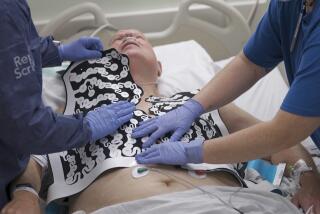Ultrasound Radiation Is Seen as New Medical Tool
- Share via
IRVINE — In a technique that one day may be used to block pain and halt mental illness, four UC Irvine researchers have discovered a way to alter brain function with short bursts of ultrasound radiation.
“This is a totally new tool,” said radiology professor Joie P. Jones, who has spent 10 years working with ultrasound on rats and believes that another five years may be needed before it can be tested on humans.
Reporting their work in the journal Brain Research, Jones and colleagues Patricia Rinaldi, Frederick Reines and LeRoy Price said they aimed short pulses of ultrasound radiation at a slice of the hippocampus, a portion of a rat’s brain kept alive in solution.
In all six experiments, the focused radiation dramatically reduced the firing of neurons in the hippocampus. Within minutes after the radiation, however, the cells returned to normal activity, the researchers reported.
Though tests on humans are years away, potential applications of this work are significant, Jones said. Ultrasound could be used to stimulate and study areas deep in the brain without harming those areas, he said. Currently an imaging technique called a PETscan uses radioactive dye to show brain function, but that is “a passive device,” Jones said. “We want to go in and disrupt or change areas of the brain and see what happens.”
Down the road, he envisions using ultrasound to treat mental disorders; for instance, a person with schizophrenia might “wear a hat or a football helmet” that would emit pulses of ultrasound to minute areas of the brain and block his hallucinations. A similar ultrasound device might be able to “disrupt certain pain centers” for those with chronic pain.
Currently psychoactive drugs can affect large areas of the brain, Jones said, “but this is the first time we’re aware of that we’re able to do this in a selective way--stop or control neuronal activity” in the tiny portions of the brain.
He predicted that in about five years ultrasound may get its first test on humans--with terminally ill patients.






